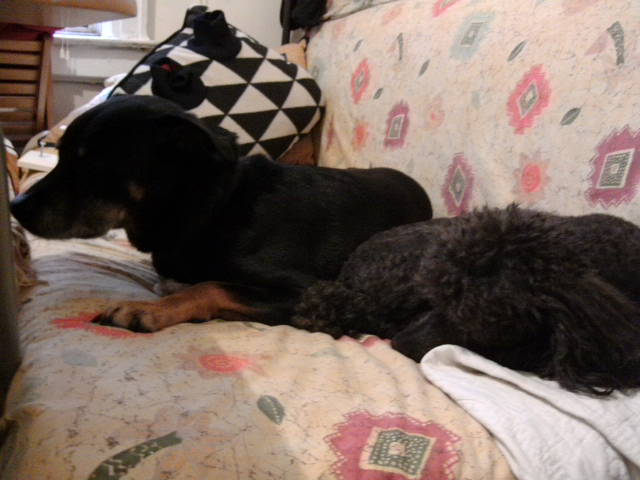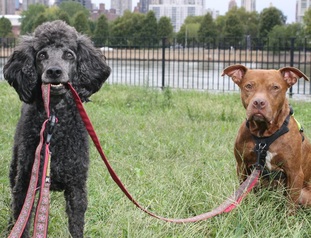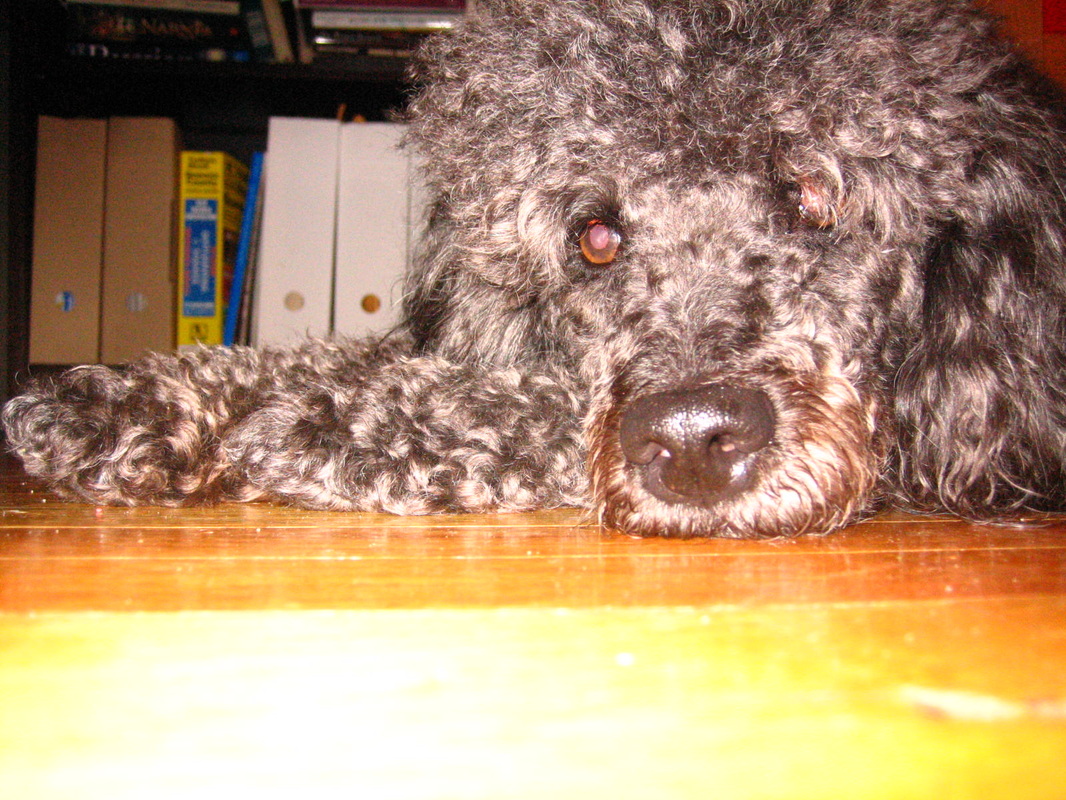|
Getting a second dog as a companion for an anxious dog is a very tricky decision that must be well thought out. Unfortunately, it's much more common for anxious behavior to spread from the resident dog to the new dog than for confidence to flow in the opposite direction. You also have to consider whether the dogs will be safe if left alone together unsupervised, and most importantly, if your dog really even wants another dog in the home. As always, I turn to my muse, Charlie. Charlie was an only dog for the first seven years of his life (all very heavy SA years). When we moved out of my mother's apartment and in with a friend in a roommate situation, we also moved in with my roommate's dog, Frog (don't you just love the name?). Charlie and Frog have similar social skills and preferences, they're both tolerant of most dogs, but have large personal space bubbles and don't really like to play with other dogs. They are both neutered males, within a year's age of each other. In other words, they got along really well. It was also during this time that I really started working with Charlie on his SA and we got into clicker training (yay!). Over time I noticed a pattern that Charlie tended to be calmer and coped better when Frog's owner left him home with Charlie than when Charlie was home alone. Charlie and Frog sharing the couch in our old apartment. It was unusual to see them so close together. Since Frog's owner would sometimes take him to work, I ended up bribing him to leave Frog at home to give Charlie (and me) peace of mind. We barely ever saw them interact, a cursory butt sniff was the pinnacle of their relationship (OK they also loved to run after the "cats" in the alley together, and Charlie would always wait for Frog to initiate - kind of cute for a generally anti-social dog), but they definitely comforted each other when home alone together by merely being in the same apartment. When it was time for Charlie and me to move out, I was understandably worried about losing a crutch and what I felt was a modest part of our training and rehab plan at the time, so I set out to find Charlie a suitable canine companion. Because Charlie is such a generally anxious dog I needed an uber mellow, relaxed dog who wouldn't feed off his waves of anxiety. I have a substantial soft spot for Pit Bulls, so went on the hunt for our perfect dog. I met many, many dogs in the next few months, several of whom I was mildly to moderately interested in, but none of them "fit" the way I needed them to. I wanted a dog who would ignore Charlie as much as he ignored them - he doesn't care for jumpy, playful dogs, and unfortunately most Pitties are jumpy, playful dogs! I also didn't want a very large dog (at the time), and was looking at those below 40#. We eventually made our way to Sean Casey Animal Rescue in Brooklyn. I spoke to the adoptions manager and explained (very verbosely and with many details) exactly what I was looking for. I had Charlie and my brother with me so we could properly assess Charlie's reaction to the new dog and vice versa safely. Without blinking the manager knew who he wanted us to meet and asked for "Sandy" to be brought out. Out walked this tiny, red, skinny, stinky, scarred up Pit Bull and my first thought (I'll admit it) was how ugly she was! She was so calm as we walked around the block. She and Charlie sniffed each other for a second and then completely ignored each other for the rest of the walk (exactly what I was looking for) but were content to walk side by side (and even fell into step!). We brought her back and saw several other dogs, none of whom felt as good as she did (they were either too interested in Charlie, too hyper for his liking, too jumpy for his liking, or were so excited about being outside, being with us, they barely noticed as they bulldozed over him in their enthusiasm, etc.). My brother and I ended up comparing them all to the little red dog, and asked to see her again at the end (can you tell where this is going?). For the second walk we sat down on a bench and she crawled and mushed all over us and wiggled her way into our hearts, all the while being very mindful of Charlie (could this be real?). I didn't adopt her that day, but after forcing myself to visit a few other shelters and meet many more dogs, that weekend we busted her outta there. The rest, as they say . . . . What a relationship built on trust looks like. Unfortunately, later on I found out that Emma has substantial resource guarding problems towards other animals (as well as troublesome reactivity to some people), so I can't ever leave them alone unattended (especially since I feed them from frozen Kongs) - even with proper training it's just not a risk I'm willing to take (I'm happy to report that she's been great after a lot of training and hasn't guarded in many months!). So Emma is crated any time I leave them alone, but this arrangement seems to work well for Charlie. We've also acquired two cats in the past year, and we all live in a small NYC studio apartment together, but they're a well-chosen bunch and complement each other nicely. It's been a very long time since Charlie has been left alone (all alone) and I don't know how much the other animals really help him cope at this point, but I have come home many times to him sleeping on the bed with one or both cats.
How does this apply to you? Well, first get to know your dog. If your dog has excellent doggy social skills, doesn't get into fights or engage in inappropriate play with other dogs, this may be an option for you (you never want to leave two dogs unattended if either or both practices unsafe or inappropriate play behavior because that can easily escalate into a fight). It is of the utmost importance that you seek a professional trainer or behaviorist to help you choose your new dog because if you're trying to help ease your current dog's anxiety, you need to be sure that: 1) Your dog would welcome another dog in the first place. 2) You choose the new dog very carefully - this is not the time to get carried away by looks or breed, you need a very specific personality-type specific to your current dog. 3) Your home set up and schedule can accommodate a second dog. 4) You need to want the second dog too! 5) You get a dog of the proper age to most benefit your dog. This is also not a good idea for dogs who are extremely anxious when left alone, currently not eating, damaging themselves, or destroying furniture, etc. This is a step to consider when you've already done a good deal of the work and your dog is experiencing much more "normal" levels of anxiety. It's simply not fair to either dog otherwise and I hope you take this warning seriously. This would never have worked for Charlie had we tried it five years ago and may have resulted in Emma developing anxiety. If you feel, however, that you and your dog may be ready for an addition but if you're not sure how a second dog would fit into your home, or if you're ready for such a commitment, fostering a dog in need of a home is always an excellent idea. Contact your local shelter or rescue and see what type of programs they have. Some will even pay for all food expenses, and most pay for medical expenses. There are short term fostering options of just a few days and longer term fostering that can last months and even years. One plus side of many is that you're saving two dogs - the one in your home, and the space you opened up at the shelter for the next dog to come in. If you end up falling in love with a foster, you can always join the ever expanding pool of "foster failures" who go on to permanently adopt their not-so-temporary friends. Be mindful though, that dogs coming from the shelter may be stressed out, which may affect your resident anxious dog and turn into a bubble of even more serious anxiety, so you please be sure to dull the edge of your resident dog's SA before trying this out (again, please seek the help of an expert!). And if your dog likes cats a lot, maybe a cat friend is more her style!
6 Comments
Medication is generally a very touchy subject; it certainly was for me when it was first recommended to me. But before I get into all the inner turmoil I dealt with and how I went back and forth for weeks before finally deciding to give it a try, I really have to emphasize that I am not a veterinarian and everything I write here is strictly regarding my experience with Charlie. If you're battling SA with your own dog and think medication can help, I strongly recommend you seek help from a veterinary behaviorist with experience prescribing for SA dogs, and if one is not available, developing a strong relationship with your regular vet is crucial. It was five years ago and Charlie was six years old. He was at his worst, SA-wise. We had just recently moved into an apartment after living in a private home for his entire life (where we let him bark all day when no one was home - there was no one to complain and we didn't take it seriously back then - in all fairness I was a teenager and although he was my best friend I had no idea what to do about his behavior) and he wasn't coping well. He was urinating on all the moving boxes and black plastic bags; he was barking continuously from the moment I left until I came home, resulting in a collapsed trachea and breathing problems that still crop up to this day; he would often lose his voice; he scratched up all the doors and windows, basically plug in your average over-the-top anxious dog behavior and he was doing it. We sort of coped with it haphazardly for some time, I don't really remember what we were doing about it, though I did, at one point, call a dog trainer to come help us. Unfortunately I was a CM fan back then and she was recommended from his site - turns out she didn't really help us much (for whatever reason she felt teaching him how to walk on a leash and giving him leash corrections was going to fix his SA. All it did was exacerbate his already delicate throat and lead to an increase in his hacking and coughing). We continued to receive complaints from the Department of Environmental Protection and were cited for his barking more than once. Then one day in 2008 it got really serious. Charlie, circa 2006, right around the time we moved and his separation anxiety sky rocketed. One of my neighbors (and I have a good hunch who it was) left us a folded piece of paper (OK this is a little graphic, so if you're sensitive, please skip to the next paragraph - I'm getting worked up just thinking about it) with a drawing of Charlie "burning in Hell" and showing how they were going to kill him (they had him hanging from a noose). Of course after that I kind of freaked out and knew that we needed to do something, immediately. On top of the note, my mom was also threatening to give him away and we were all going through a lot of personal problems. It got so bad that I shipped him off to live with my father in New Jersey for a few weeks - it was the hardest thing I've ever done. That didn't last long, since my dad didn't know what to do with his problem anymore than we did. I'll admit that I tried a Citronella anti-bark collar. It didn't work. For whatever reason I could never get it to sit right on him, so it ended up spraying the side of his face, or missing his face altogether and I would just come home to an extra-uber-anxious dog who smelled like citrus. To be perfectly honest, I'm sure that even if I did get it to work correctly it would never be enough to dampen the level of anxiety he used to experience back then, really it just made him worse. I tried for months and months a variety of other things that any person recommended, including putting a nylon muzzle on him during the day. Besides being incredibly stupid and dangerous (if he needed to vomit he would have died, if he got too hot, he would have died, and a bunch of other "ifs" that could have ended in his death bother me deeply to this day) it just made his anxiety worse. We used it as a crutch for longer than I'd like to admit to, since it pacified our neighbors and stopped the death threats and calls to the police, but it always made me uneasy and he hated it more than I want to remember. Note: nylon muzzles should only be used for short periods under direct supervision for things like veterinarian visits, grooming appointments, and other short-term handling experiences. If you need to muzzle your dog for aggression-related behavior, you must get a properly fitted basket muzzle that will allow your dog to safely pant, drink, and even take treats. My favorite basket muzzle is the Baskerville Ultra Muzzle. Please learn from my mistakes and don't put your dog at risk! I really lucked out but could easily have come home to a dead dog. Despite all the damage I did to him back then (and from what you can see, there was quite a lot), I am somewhat proud to say that although I considered buying an anti-bark electronic collar, I never did, and I hope that you never have to consider it. My first truly constructive step was to wake up two hours early every day and take him running in the hopes that it would exhaust him (if you read my previous post, you'll know that it did help quite a bit, and even got me in shape too!). I also started asking him to wait to be fed before I left in the mornings (was still using a bowl at that time) and would release him just before I left (thankfully he was always willing to eat, which isn't always the case with SA dogs). It was around this time that I met the person who introduced me to clicker training and I attended the 2009 Clicker Expo in Rhode Island. Finding this "new" way of training was really a godsend for Charlie and me. We both took to it like naturals and have never looked back. After the Expo I was hooked (and left all barbaric training behind), joined an online forum for clicker training, and wrote about my Charlie woes. Someone on the list brought up the fact that I should seriously consider getting him on some type of medication. My first response was to recoil in disgust, stating all these "facts" I knew about modern medication and all about how it would make him sleepy and lethargic and how I would never do that to my dog (yes, folks, hypocrisy at its finest). Prozac for dogs was a joke! Only really unbalanced people even considered it! (I should probably add here that I'd tried all the OTC remedies that everyone suggested - everything from Benadryl to flower essences and nothing worked - I think the Benadryl actually made him more anxious. In my experience he'd always been very resistant to drugs and even needed higher doses of anesthesia for surgery, but I attribute that to his anxiety as well. It was just another factor that made me feel drugs weren't the answer.) But she was patient, and blunt with me and pointed out (which I still very clearly remember) that if he were diabetic, I would get him insulin, right? Well, of course, I said, he'd need it. Well, then, she countered, he may actually have imbalances in his brain that make it impossible for him to relax, he needs the medication to help him think clearly - to be able to dull the edge of his anxiety just enough so he can learn how to be calm without it. Oh, I thought. I didn't even consider that. She went on to explain that modern medication, especially the types and doses used for anxiety, often don't have side effects, and if they do, there are many options to try out. She also explained how the medication worked in the brain (which I've all but forgotten) but pointed out that most of these medications (at least the ones I should be interested in) took weeks to take effect and weren't used for immediate sedation. I sort of gathered my pride and went to see my veterinarian about this. Charlie had always been very unhappy about the vet's office, so she was well aware that he had anxiety issues (understatement of the year?). I brought up medication and she was on board with my plan. We started him on a low dose of Clomicalm. My vet said that she had had good success with this drug and preferred it to Prozac for starting out, and we increased it after a few weeks. I didn't keep a log at the time, but I think it took six weeks or so for me to notice any significant changes in his behavior. (By this time Charlie and I were also no longer living with my mother and were sharing an apartment with a dog-savvy friend. He was much happier in the new place, although the move was stressful, as could be expected.) And then he just kept getting better and better. It certainly helped that I was gaining skills as a trainer quite rapidly (and he learned most of his 100+ tricks and behaviors during this time!) and was gung-ho about our training plan, so was able to develop a behavior modification treatment for him with the help of the wonderful people on the forum. I also started working in the dog world and was able to take him to work with me almost every day where he was learning it was OK to not be right next to me every second. Circa January 2010, a few months into his medication treatment. Charlie is a generally anxious dog (to this day he's more anxious than your average dog and always will be) but for the first time in his life he was able to relax. His SA slowly got better, though I was a little anal about not leaving the house more than I had to (for a long time he was stuck to a routine that dictated I was only allowed to leave the house once a day - it was so ingrained in me for so long that to this day I have a really hard time leaving more than once, even though now I can!).
There were a lot of facets to his recovery, some which I have already covered in previous posts, and others which are still to come, but the medication was what allowed him room enough in his brain to think and be able to relax on his own. From my experience with him, I can confidently say that it's absolute folly to force a dog to deal with situations they're incapable of dealing with on their own, without the proper tools (of course this doesn't apply only to medication!). Certainly not all dogs need medication for every problem, but when you and your dog are really struggling, there's nothing wrong with getting support where appropriate. I just want to add that only very recently (within the past year) I learned about canine thyroid disease and that it can have many, many manifestations in dogs that were previously unattributed to it. Dr. Dodd's wrote an excellent book on the subject and if you plan to get your dog tested (which you should!), I highly recommend you do it through her lab (they were actually less expensive than my regular vet!). Since confirming that Charlie is hypothyroid and getting him on the proper dose of thyroid medication, I have noticed that he's calmer than ever, almost dramatically so, and a good deal of his anxiety in the past ten years may have been thyroid-related. To kind of underline that, I have also been able to wean him off onto the smallest dose of anti-anxiety medication he's ever been on, it's actually half his starting dose! We also switched him to Prozac off of Clomicalm this year for a variety of reasons, the most important of which is that Prozac is generally considered to be safer and has fewer side effects. He's currently on 5 mg twice a day (which is a very low dose). I'm hoping to lower it even more to just 5 mg once a day, but of utmost importance to me is that Charlie's content, so we're taking it very slowly. (I have tried weaning him off in the past to disastrous results, which really underscores how crucial the medication is to his mental well-being.) If you'd like more information on the various anti-anxiety medications available, this is an excellent site to check out. If you're currently battling with the separation anxiety monster, I wish you patience, love, acceptance, and the clarity of mind to make the right choices for your dog. After a long, and much needed holiday hiatus, we're back to talk more about Separation Anxiety!
Some people swear by it, others feel it's barely more than an old wives' tale, but background noise and music therapy definitely have their place in the fight against SA. In my experience, background noise can be a huge aid, especially when used correctly. If you've followed all the suggestions in the previous posts, your anxious dog will be well exercised and busy which will help her to get through the difficult first thirty minutes or so. But what happens when she hears a noise two hours later which incites her to bark, and then leads to her old patterns with no cue to help her stop? That's where music therapy and background noise come in. Just leaving something on all the time, like a radio or the television, can help mimic what your home sounds like when you're home. I'm one of those people who generally has something babbling in the background all the time, and I can only imagine the stark contrast it would be for Charlie if it was dead silent when I was gone during the day. Background noise can also help muffle regular daytime noises that might set off an anxious dog. Everything from other people in your building entering and exiting, dogs barking outside, the mailman, construction workers, trucks driving by, and the dreaded doorbell, etc. can all set off an anxiety attack for your dog. Muffling these triggers with background noise can really help. Over the years I've been able to lower the level of the music I leave on for Charlie from obnoxiously loud to pleasantly static background noise. I also feel that they help him get back to "normal" if there is a trigger that causes him to bark. Instead of an empty void there's a "presence" - most important if your dog is an only dog. You can certainly just leave the usual music/TV/radio that you have playing while you're home (which I often do). It may take a few attempts to find what level is appropriate for your dog and your home. Also keep in mind what you're leaving on. Something like Animal Planet may actually trigger your dog to bark/become anxious (a dog barking on the TV might trigger a response - "know thy dog" is a great mantra!), while something you dislike (like the sports channel for me) might comfort your dog (monotonous human voices). Over time I found that my dogs do well with classical music, jazz, and the like (and I don't squirm when I come home!). There has been a revolution in canine music therapy, most notably by the creators of Through a Dog's Ear, Lisa Spector and Joshua Leeds. From their website: "The music of Through a Dog’s Ear builds on the ground breaking psychoacoustic research of Dr. Alfred Tomatis (1920-2001). Known as the “Einstein of the ear,” Tomatis discovered the extraordinary powers of sound as a “nutrient for the nervous system.” His therapeutic discoveries redefine modern psychoacoustics — the study of the effect of music and sound on the human nervous system. These recordings are psychoacoustically designed to support you and your dog’s compromised immune or nervous system function. When the immune or nervous system is heavily taxed, a natural reaction is to self-limit the amount of auditory or visual stimulation coming into the system. However, the “nutrients” of sound are needed the most when life energy is at a low ebb or when neurodevelopmental (including sensory) issues are present. To facilitate maximum sound intake while conserving energy output, the method of simple sound has been created." They have a variety of CDs with different purposes, some are generally calming, others are specifically for the car, and they have recently teamed up with the lovely Victoria Stilwell of It's Me or the Dog to create The Canine Noise Phobia Series which can help not only with SA but also with helping in the prevention of noise phobias. If you're serious about aiding your dog, you really must give these CDs a try. In my experience, when I play the CDs I feel sleepy and relaxed, so I can only imagine how it helps my dogs cope! There has also been an overwhelming amount of anecdotal evidence when these CDs were played in shelters - the dogs were much calmer and much more adoptable. May trainers play them in their facilities and I know many people who have had great success using the CDs. If you are going to buy the CDs, make sure to check out the special offers tab where they have wonderful introductory offers. In the next post we'll cover medication, which is a touchy, but necessary subject, so stay tuned! |





 RSS Feed
RSS Feed

